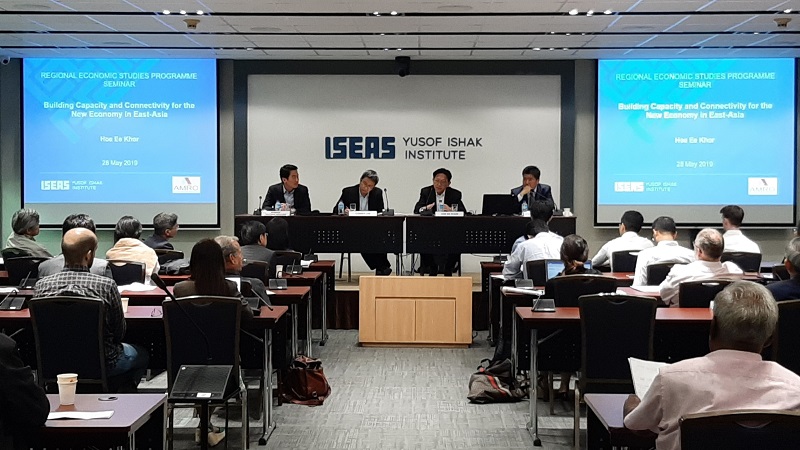
Panelists discuss the regional economic outlook and the prospects at the AMRO-ISEAS joint seminar in Singapore on May 28, 2019. From left to right: Dr. Siwage Dharma Negara, Senior Fellow at the Regional Economic Studies Programme of ISEAS; Dr. Cassey Lee, Senior Fellow and Coordinator at the Regional Economic Studies Programme of ISEAS; Dr. Hoe Ee Khor, AMRO Chief Economist; and Dr Hak Bin Chua, Senior Economist at Maybank Kim Eng.
The ASEAN+3 economies are in a solid position to mitigate economic headwinds from the escalation of the US-China trade tensions, which have dampened the economic outlook in the region. This encouraging outlook was highlighted by economists and experts during a seminar co-organized by the ASEAN+3 Macroeconomic Research Office (AMRO) and the Institute of Southeast Asian Studies (ISEAS)—Yusof Ishak Institute in Singapore in late May 2019.
The joint seminar, entitled “Building Capacity and Connectivity for the New Economy in East Asia”, used key findings from AMRO’s recently launched ASEAN+3 Regional Economic Outlook (AREO) 2019 as background for the discussion.
In his keynote presentation, AMRO Chief Economist, Dr. Hoe Ee Khor highlighted that despite rising challenges in the global economy, the ASEAN+3 region remains resilient, buttressed by strong fundamentals.
Dr. Khor also mapped out the risks that the region faces. He highlighted that open economies, which are deeply integrated within the global supply chains, like Singapore and Korea, are particularly vulnerable to global threats such as the escalating tensions on trade and technology between the United States and China and the downturn in global economic activity. He noted that the region’s dependence on extra-regional demand has fallen sharply from 44 percent to 30 percent over the years. However, he also pointed out that Singapore, with more than 60 percent of its economy dependent on external demand, is likely to be more heavily affected by trade shocks. He suggested that Singapore and other economies in the region should respond by continuing to leverage on intra-regional opportunities for growth.
Discussant Dr. Siwage Dharma Negara, a Senior Fellow at the Regional Economic Studies Programme of the ISEAS-Yusof Ishak Institute, suggested that the trade conflict has expanded beyond tariff measures. Dr. Siwage argued that any impact from non-tariff measures, such as a technology ban, would be difficult to evaluate. Dr. Hak Bin Chua, Senior Economist at Maybank Kim Eng, echoed this point and added that there might be spillover effects from the technology war onto other East Asian economies, which are part of the electronic supply chain.
On trade diversion effects, Dr. Chua pointed out that although more companies are shifting production into ASEAN countries, not all countries benefit equally from this reconfiguration of the global supply chain. Dr. Negara agreed, noting that countries with more open economies and better regulatory frameworks invite more foreign direct investment.
Talking about the longer-term prospects for the region, Dr. Khor pointed out that technological advances have resulted in automation, and demographic changes have given rise to greater demand for higher quality goods and services. The region, therefore, has to embrace the “new economy” to create quality jobs and satisfy the new demand. To create a favorable ecology for the “new economy,” regional economies need to invest in both hard and soft infrastructure.
The seminar ended with the panel agreeing that there are opportunities that the region could tap on to enhance capacity building and connectivity, including strengthening regional financial safety nets and leveraging on regional investments and savings. Economies in the region can tap on programs like the Belt and Road Initiative, as well as the Master Plan on ASEAN Connectivity 2025, to propel connectivity projects. As data-based technologies and services benefit from economies of scale, regional economies should also work towards achieving a seamless flow of data among themselves to benefit from lower costs and higher quality of said technologies and services.
